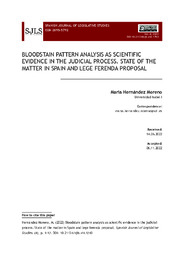Por favor, use este identificador para citar o enlazar este ítem:
https://hdl.handle.net/11000/29002Registro completo de metadatos
| Campo DC | Valor | Lengua/Idioma |
|---|---|---|
| dc.contributor.author | Hernández-Moreno, María | - |
| dc.contributor.other | Departamentos de la UMH::Ciencia Jurídica | es_ES |
| dc.date.accessioned | 2023-03-20T12:27:27Z | - |
| dc.date.available | 2023-03-20T12:27:27Z | - |
| dc.date.created | 2022 | - |
| dc.identifier.citation | SPANISH JOURNAL OF LEGISLATIVE STUDIES No. 4 (2022) | es_ES |
| dc.identifier.issn | 2695-5792 | - |
| dc.identifier.uri | https://hdl.handle.net/11000/29002 | - |
| dc.description.abstract | El análisis de patrones de manchas de sangre brinda al proceso judicial la oportunidad de proporcionar, estudiar y evaluar pruebas veraces e imparciales, lo que facilita la toma de decisiones objetivas por parte del jurado. Sin embargo, existe un desconocimiento de la disciplina y de las normas legislativas relacionadas con la formación de expertos y sus informes en España. Esto complica el desarrollo de este tema y reduce su veracidad. Con la intención de brindar medidas que faciliten su crecimiento de manera garante, se ha analizado la legislación, las sentencias relacionadas y los estándares de formación de los policías encargados de la investigación de patrones de manchas de sangre. El propósito es el de probar el valor del análisis de patrones de manchas de sangre como disciplina. La importancia de la función auxiliar que ejercen los peritos en esta materia se pondrá de manifiesto también a través de los informes presentados en distintos procesos judiciales. | es_ES |
| dc.description.abstract | Bloodstain pattern analysis provides the judicial process with the opportunity to afford, study and asses truthful and unbiased evidence, which facilitates objective decision making by the jury. However, there is a lack of knowledge of the discipline and of legislative standards related to the training of experts and their reports in Spain. This complicates the development of this subject and reduces its veracity.With the intention of providing measures that facilitate its growth in a guaranteed way, legislation, related rulings, and the training standards of police officers in charge of bloodstains pattern investigations have been analyzed. In addition, an international vision has been provided with the discipline’s situation in the United States, the cradle of its development.The purpose proving the value of bloodstain patterns analysis as a discipline. The importance of the auxiliary function that experts hold in this matter will be shown too through the reports presented in different judicial processes | - |
| dc.format | application/pdf | es_ES |
| dc.format.extent | 17 | es_ES |
| dc.language.iso | eng | es_ES |
| dc.publisher | Universidad Miguel Hernández de Elche | es_ES |
| dc.rights | info:eu-repo/semantics/openAccess | es_ES |
| dc.rights.uri | http://creativecommons.org/licenses/by-nc-nd/4.0/ | * |
| dc.subject | Bloodstain pattern analysis | es_ES |
| dc.subject | Informe pericial | es_ES |
| dc.subject | Spanish expert evidence situation | es_ES |
| dc.subject.other | CDU::3 - Ciencias sociales::34 - Derecho | es_ES |
| dc.title | Bloodstain pattern analysis as scientific evidence in the judicial process. State of the matter in spain and lege ferenda proposal | es_ES |
| dc.type | info:eu-repo/semantics/article | es_ES |
| dc.relation.publisherversion | https://doi.org/10.21134/sjls.vi4.1743 | es_ES |

Ver/Abrir:
1743-Article Text-8049-2-10-20230302.pdf
303,66 kB
Adobe PDF
Compartir:
 La licencia se describe como: Atribución-NonComercial-NoDerivada 4.0 Internacional.
La licencia se describe como: Atribución-NonComercial-NoDerivada 4.0 Internacional.
.png)